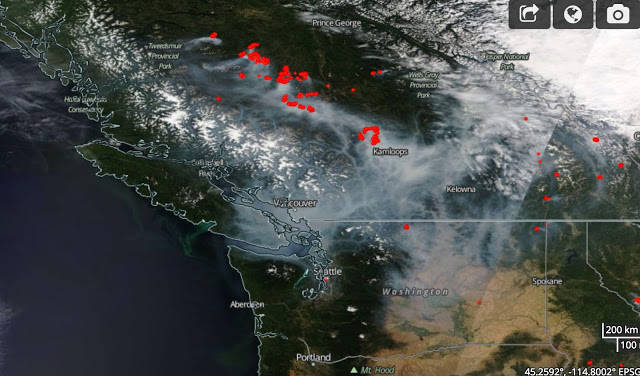Michael Riordan
Special to the Journal
During the recent smoke surge into northwest Washington from Canadian fires, San Juan County was flying blind in a fog, without instruments.
Every other county in the Puget Sound area belongs to one of three regional clean air agencies, which monitor the local air quality to help inform citizens and government leaders about potential problems, recommending possible responses. At multiple stations, they measure quantities like particulate matter, ozone, sulfur dioxide, and carbon monoxide levels. In the recent incident, for example, particulate matter rose to “unhealthy” levels throughout Puget Sound, especially impacting sensitive groups like asthmatics and older people. For several days, it seemed like we were living in Beijing. Burn bans went into effect, and people were advised to avoid strenuous outdoor activities.
But San Juan County has no capacity to monitor local air quality. Why not?
In its infinite wisdom, the San Juan County Council decided over a decade ago that such a capability was not worth the cost. I first learned about this decision from Rick Hughes when I asked the question during opposition to the Cherry Point coal terminal. At that time, the cost of joining the Northwest Clean Air Agency and getting a monitoring station established here — say in Eastsound or Friday Harbor — was a paltry $8,500 per year. But Rick quickly estimated what fraction of an FTE (full-time equivalent salary) would be required to cover this fee. Somehow the wealthiest county in Washington state could not afford to pay about four bits (50 cents) per person. That ended the discussion.
But it, unfortunately, didn’t end the need, as last week’s suffocating smoke pollution underscored. I had to look up figures for Anacortes and Bellingham to get even a rough idea of the local levels of fine particulate matter, the worst kind, which can easily enter the blood steam from the lungs. And it may well have been worse, as a large smoke stream flowed from inland British Columbia through the Fraser River gap directly toward the San Juan Islands (see August 1 satellite photo).
This kind of pollution especially hurts older people, who comprise a large percentage of the county population. And it must have affected the bicyclists, kayakers and other outdoor sports enthusiasts, who swarmed to these islands this summer, as they do every summer. Indeed, when I went out paddling Saturday afternoon, I felt short of breath and ended early.
In winter, smoke from wood stoves is probably the principal contributor to particulate-matter levels, according to NWCAA officials, especially when the wind dies down and the smoke collects in hollows and valleys. Plenty of island homes are heated that way, so the problem can become severe. But without measurements, we just don’t know.
And if a major release of sulfurous gases like sulfur dioxide ever occurs, say from anchored or passing oil tankers and other vessels, we‘d certainly smell it but would not know how severe the problem was nor where it originated.
The regional clean air agencies do a world of good for every other county in the Puget Sound area, monitoring local air quality and keeping it healthy at nominal cost. The Northwest Clean Air Agency has talented, hardworking engineers and other professionals, with whom I have worked on coal-terminal and oil-refinery emissions. They deserve our support, and we definitely need what they can offer.
It’s high time San Juan County stopped being penny wise and pound foolish, and instead joined this agency.




